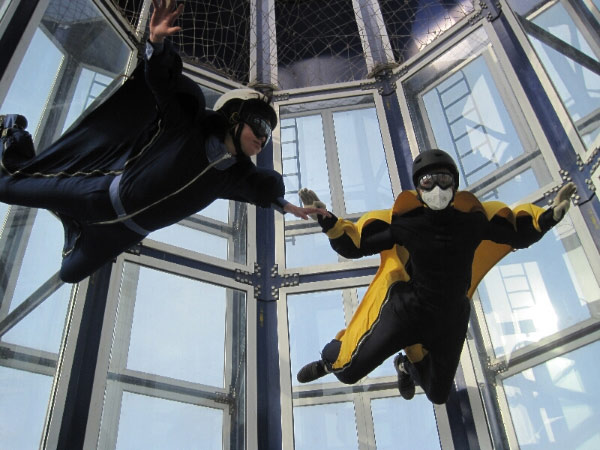Fly like a bird
Updated: 2013-03-31 08:22
By Wu Ni (China Daily)
|
||||||||
|
 Wearing a helmet and specially designed flying costume, an experienced player can float up and down, and even swirl in the air. Photos Provided to China Daily |
If you have always wanted to head for the heavens, Wu Ni suggests you try a vertical wind tunnel in Shanghai.
A vertical wind tunnel near the Shanghai Circuit is offering sports lovers the chance to experience the feeling of flying - without the fear of jumping from a plane or falling out of the sky.
Drive from downtown Shanghai along the Shanghai-Jiaxing expressway for about 50 minutes, you will see an about 20-meter-tall vertical column framed by two tower buildings in the vast suburban land.
Climb up the building to get a closer look at the wind tunnel. The column is built with toughened glass walls and separated into two floors of cabinets by steel wire. Six giant air blowers installed at the bottom of the cabinet can generate fast and powerful air stream that blow you up in the air.
Wang Yantu, 23, a tutor of the vertical wind tunnel experiencing center, is there to show visitors how to fly and fly beautifully.
Wearing a helmet, protective goggles and a specially designed flying costume, Wang confidently walks into the cabinet and stands on the steel wire grid. The air blowers thunder and his costume, especially the two sleeves which are designed like wings, rise up in the wind.
Wang spreads his arms as if he is embracing someone and then slowly pitches forward. As the roaring of machine rises, his two legs get rid of the bond of gravity and his body gradually floats in the air, belly downward. He floats up and down, and even swirls in the air.
"The key is to relax, focus and keep balance, or else, you may not maintain floating but roll over and lose control of the body," he says.
"It feels like swimming in the air - you are free and the air stream supports you just like water," Wang says. "It is so exciting."
Before stepping into the flight cabinet, participants should join a 45 minutes' coaching program. Wang teaches them to simulate gestures of floating, do warm-ups, learn gestures to express "I am OK" or "I feel bad" during flying as they can hear nothing but roaring winds in the cabinet.
It costs 280 yuan ($45) to experience two minutes of flying in the air.
Zhou Xu, general manager of Shanghai Creator Wind Energy Technology which produced the wind tunnel, dismisses the challenge that the price is staggering.
"The sport has its niche. There are people who want to try it no matter how much it costs. This is a secured extreme sport that is suitable for people from 4 to 80," he says. There are layers of protection webs at the bottom of the tunnel, but people who weigh heavier than 100 kilograms are not suggested to try the sport.
The technology that lets you float in the air is hardly new, Zhou says. As early as in the 1970s, the US army developed the facility to train parachuters.
Aerodium engineer Jean St. Germain proudly trumpeted it in National Geographic magazine back in 1982, three years after he built his first wind tunnel. The sport also served as the main act for the Closing Ceremony of the 2006 Winter Olympics in Turin.
It is now widely applied as a recreational wind tunnel, also known as indoor skydiving or body flight.
China now has only three such wind tunnels. The other two are located in Sichuan and Liaoning provinces.
The high cost limited the spreading of the sport, according to Zhou, who only would vaguely reveal that his company invested tens of millions of yuan to build the facility.
They do not accept individual guest now. Those who want to try should make an appointment by phone and form a group of no less than 10 people.
Contact the writer at wuni@chinadaily.com.cn.

 'Taken 2' grabs movie box office crown
'Taken 2' grabs movie box office crown
 Rihanna's 'Diamonds' tops UK pop chart
Rihanna's 'Diamonds' tops UK pop chart
 Fans get look at vintage Rolling Stones
Fans get look at vintage Rolling Stones
 Celebrities attend Power of Women event
Celebrities attend Power of Women event
 Ang Lee breaks 'every rule' to make unlikely new Life of Pi film
Ang Lee breaks 'every rule' to make unlikely new Life of Pi film
 Rihanna almost thrown out of nightclub
Rihanna almost thrown out of nightclub
 'Dark Knight' wins weekend box office
'Dark Knight' wins weekend box office
 'Total Recall' stars gather in Beverly Hills
'Total Recall' stars gather in Beverly Hills
Most Viewed
Editor's Picks

|

|

|

|

|

|
Today's Top News
Boston bombing suspect reported cornered on boat
7.0-magnitude quake hits Sichuan
Cross-talk artist helps to spread the word
'Green' awareness levels drop in Beijing
Palace Museum spruces up
First couple on Time's list of most influential
H7N9 flu transmission studied
Trading channels 'need to broaden'
US Weekly

|

|








